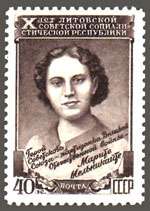Marytė Melnikaitė
| Marytė Melnikaitė | |
|---|---|
 Melnikaitė on 1950 Soviet postal stamp | |
| Born |
March 18, 1923 Zarasai |
| Died |
July 13, 1943 (aged 20) Kaniūkai, Ignalina district |
| Allegiance |
|
| Awards |
|
Marytė or Marija Melnikaitė (March 18, 1923 in Zarasai – July 13, 1943 near Kaniūkai) was a Soviet partisan, the only Lithuanian woman awarded Hero of the Soviet Union.[1]
Melnikaitė was born to a family of a Russian mother and a Lithuanian father.[2] She had four other siblings and the parents took assorted jobs to provide for the large family. Melnikaitė started working at Avanti confectionery at age 14 and studied sewing. In 1940, after Lithuania was occupied by the Soviet Union, Melnikaitė joined Komsomol and started evening classes. Reportedly her father did not approve her Komsomol activities, which included her singing in a choir.[2]
After the German invasion of the Soviet Union, Melnikaitė along with other Komsomol members was evacuated to Russia where she took a job at a machine tool plant in Tyumen.[2] In July 1942, she joined the Soviet Army (16th Rifle Division) and was sent to a saboteur school in Balakhna.
In May 1943, she finished the studies and was sent to Belarus and then back to her native Zarasai where she joined the Soviet partisan group Kęstutis under the name of Ona Kuosaitė.[2]
Melnikaitė's partisan life lasted less than two months. In July 1943, she and several other partisans were sent on a mission to bring more weapons from Soviet partisans operating in Belarus. Local inhabitants spotted the group near Apvardai Lake in Ignalina district and called Lithuanian policemen. During a shootout, several partisans were killed, while Melnikaitė was captured. Her custody was transferred to the German police. After five days of torture she was shot in the cemetery of Kaniūkai village.[2]
The death of the twenty-year-old was used by Soviet propaganda, which exaggerated her duties, accomplishments, and circumstances of her death. For example, in March 1944, Antanas Sniečkus wrote in Tiesa that the shootout lasted a day and that Melnikaitė personally killed seven policemen, was badly injured, attempted to commit suicide with a grenade, and even after brutal torture did not betray her fellow partisans.[3] She was awarded Hero of the Soviet Union on March 22, 1944.
Honors and memorials
- Memorial museum in Zarasai (1969); closed[4]
- Monument in Druskininkai (1952); sculptor Robertas Antinis, currently located in Grūtas Park
- Monument in Zarasai (1955); sculptor Juozas Mikėnas, currently located in Grūtas Park
- Plaque on the intersection of Melnikaitė and Republic streets in Tyumen
- Plaque on the machine tool plant in Tyumen (the former factory "Mechanic")
- Film Marytė by Mosfilm (1947); directed by Vera Stroyeva, small debut role of Donatas Banionis[5]
- Opera Marytė by Lithuanian Opera and Ballet Theatre (1953); directed by Antanas Račiūnas[6]
- Essay Tarybų Sąjungos Didvyrė Marija Melnikaitė by Antanas Venclova (1944)
- Poems Marija Melnikaitė by Salomėja Nėris, Lietuvos duktė by Vacys Reimeris, Tam krašte by Vladas Mozūriūnas[7]
- One of the main streets in Tyumen was named in her honor; also streets in Minsk, Almaty,[8] and Shymkent[9]
- Textile company in Utena was named in her honor;[10] renamed to Utenos trikotažas in 1995
- Kolkhozes in Dotnuva (the first in the Lithuanian SSR) and several others were named in her honor[10]
See also
References
- ↑ Heroines of the Soviet Union 1941-45 by Henry Sakaida, page 52
- 1 2 3 4 5 Balikienė, Brigita (2006-01-09). "Diversantė MM". Istorijos. ISSN 1822-3761.
- ↑ K. Ėringis. Lietuvos kariuomenės tragedija. Faktai, prisiminimai, dokumentai. Vilnius, 1993, pages 145-148
- ↑ Zarasų krašto muziejus
- ↑ Historical Dictionary of Russian and Soviet Cinema by P. Rollberg, page 671
- ↑ A Short History of Opera by Donald Jay Grout, Hermine Weigel Williams, page 672
- ↑ Tarybinė lietuvių poezija didžiojo tėvynės karo metais by Elena Baliutytė, page 42
- ↑ Поуличный телефонный справочник Алматы (Алма-Аты)
- ↑ Улица Невезения в Шымкенте, там застревают даже большегрузные КАМАЗы
- 1 2 Tarybų Lietuvos enciklopedija, volume 3, page 45